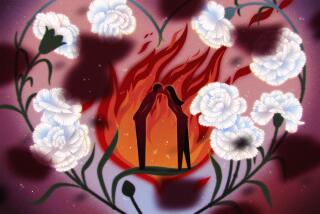A look at how love found its way into matrimony
- Share via
Marriage, a History
From Obedience to Intimacy or How Love Conquered Marriage
Stephanie Coontz
Viking: 432 pp., $25.95
*
Having deconstructed the post-World War II American family in her acclaimed book, “The Way We Never Were,” Stephanie Coontz now moves back in time for “Marriage, a History: From Obedience to Intimacy or How Love Conquered Marriage.” How, she asks, did marriage get to its present chaotic state? The material is assembled with professional expertise and produces a convincing narrative.
Traditional marriage before the 19th century was essentially a union between families rather than individuals, the aim of which was “to acquire useful in-laws.” Upper-class families arranged marriages for their children in the interest of making powerful social and political alliances, while the middle and lower classes were motivated largely by economics. The well-being of the individual was almost always subordinate. A prospective husband had little or no say in the choice of his spouse, and the prospective wife had even less.
But, over time, “a distinctive marriage system had taken root in Western Europe ... different from marriage anywhere else in the world.” For one thing, polygamy, practiced in many non-Christian countries, had been outlawed in Europe from the 12th century onward. For another, most couples in Northern Europe usually established their own households, independent from their parents’ home and authority.
But the major change had to do with how marriages were contracted in the first place. Gradually, from the late 16th to the late 18th century, nubile men and women in Great Britain, Europe and North America liberated themselves from parental dictates and chose spouses for themselves.
By the 19th century, love-based marriages had replaced arranged marriages as the social norm. The popular image of husbands and wives changed from that of dutiful “yoke mates” to that of romantic “soul mates.”
As marriage evolved during the Victorian era, it became more and more standard for the breadwinning husband to work away from home and for the wife to remain within the domestic confines, at least in the classes that could afford to have a nonemployed spouse. Yet this presumably love-based, consensual marriage of separate spheres, which took centuries to develop, took only 25 years to disintegrate.
From the 1960s to the 1980s, the institution of lifelong marriage began to have serious rivals in the form of liberated sexual liaisons, cohabitation, divorce, serial marriage and single parenting.
With new educational and economic opportunities, women (if they married at all) began to wed at a later age than their mothers had and, because many could support themselves without husbands, they were less willing to enter into or remain within unsatisfying unions.
Although almost all individuals believe, at the time of the wedding, that their marriage will last forever, statistics tell a different story: roughly one out of two American marriages ends in divorce, and divorce is rarely pretty. It is an upsetting life experience, it wreaks havoc in the lives of children and unsettles friends and relations, especially the oft-overlooked parents of the couple, who are often devastated by their children’s divorces. Despite these hazards, Coontz believes that marriage remains “the highest expression of commitment in our culture.” And even as couples stumble into uncharted conjugal territory, they “do have a clear set of rules about what each partner should not do.” On this cautionary note, Coontz concludes that American society is learning to accept the new faces of marriage, including same-sex unions with or without the marital label.
Building on the work of numerous other studies, “Marriage, a History” offers an updated investigation, with myriad examples not easily found elsewhere. And while the author focuses primarily on Euro American civilization, she does so with an eye to other cultures, giving examples from Asia and Africa as well as the Kwakiutl of the Pacific Northwest. These occasional forays into the non-Western world mute the criticism so often leveled at American historians of the family (myself included) that we can’t see beyond our own borders.
In a work of such scope, there are, of course, a few errors. One is a statement about the chess queen. She did appear on the European board in the early Middle Ages as a replacement for the Arabic vizier (counselor). She was not, however, a powerful piece at that time. It took 500 years for her to evolve into the most powerful piece, and when she did, it happened very quickly, in about 25 years.
What does all this have to do with marriage? Only that marriage, too, has mutated very quickly during the last quarter century into a new institution, one in which the wife’s increased status has changed the whole nature of the game. Like chess players in the early 1500s, today’s couples have to learn to play by different rules. In providing the long view of history, Coontz gives us reason to believe that they can and will accommodate such radical change.
*
Marilyn Yalom is the author of “A History of the Wife” and “Birth of the Chess Queen.”


